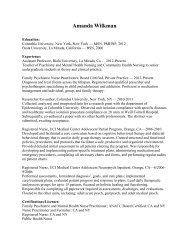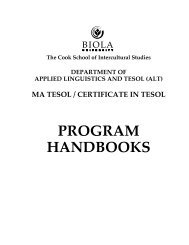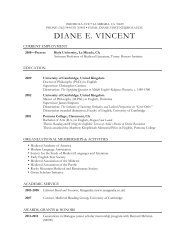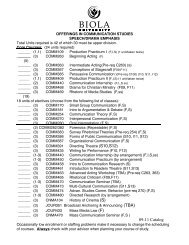GRADUATE STUDENT HANDBOOK - Biola University
GRADUATE STUDENT HANDBOOK - Biola University
GRADUATE STUDENT HANDBOOK - Biola University
You also want an ePaper? Increase the reach of your titles
YUMPU automatically turns print PDFs into web optimized ePapers that Google loves.
the Chief of Campus Safety and one faculty member. At least four members must be present to convene<br />
the committee. The Dean of Students (or designee) serves as the discipline process facilitator for all<br />
sexual assault cases and may be present during the hearing. The facilitator‘s role is to assist the Chair<br />
and to ensure compliance with the process and procedures outlined below.<br />
It is expected that SAHC members will exhibit the highest ethical standards and disqualify themselves if<br />
they believe they cannot be impartial or fulfill their obligation to maintain the confidentiality of the<br />
process and the dignity and privacy of the respondent, the complainant, and any witnesses before,<br />
during, and/or after the hearing. Both the respondent and complainant may raise issues of concern about<br />
the impartiality of a member of the SAHC convened for a particular case. The Dean of Students has the<br />
sole discretion to decide whether a SAHC member can be impartial and will remove anyone whom<br />
he/she determines is unable to be impartial and/or respectful of the confidentiality of the process and<br />
privacy of the individuals involved.<br />
*The Dean of Student Development and Dean of Students are two separate positions.<br />
XI. Outline of Sexual Assault Hearing Committee (SAHC) Proceedings<br />
1. SAHC proceedings are closed to all parties except the individual student(s), the SAHC members,<br />
the Dean of Students or designee, witnesses, and the respective student‘s advisor. The complainant and<br />
respondent will be absent from the room while the other party and any witnesses appear before the<br />
SAHC.<br />
2. The Chair will convene the SAHC.<br />
3. The Chair will introduce the SAHC members to the complainant and explain the process.<br />
4. The complainant will be asked to make a statement and respond to questions from the SAHC<br />
members. The complainant will be excused until recalled for further questions and/or a final statement.<br />
5. The Chair will invite the respondent into the hearing and will introduce the SAHC members to<br />
the respondent and explain the process.<br />
6. The respondent will be asked to make a statement and answer questions from the SAHC<br />
members. The respondent will be excused until recalled for further questions and/or a final statement.<br />
7. Any witnesses will individually be asked to make a statement and respond to questions from the<br />
SAHC.<br />
8. All participants must be available for recall by the SAHC for additional questioning until the<br />
chair excuses them.<br />
9. The Chair will give members of the committee the opportunity to ask the respondent any followup<br />
questions, and will give the respondent an opportunity to make a final statement to the SAHC. The<br />
respondent is then excused from the proceedings.<br />
10. The Chair will give members of the committee the opportunity to ask the complainant any<br />
follow-up questions, and will give the complainant an opportunity to make a final statement to the<br />
SAHC. The complainant is then excused from the proceedings.<br />
11. The SAHC will deliberate in private and weighing all of the evidence, the SAHC must determine<br />
whether it is more likely than not that a sexual assault occurred. This level of proof is commonly<br />
referred to as a ―preponderance of the evidence.‖ This level is a lesser level than that in the criminal<br />
justice system, which requires that a case be established ―beyond a reasonable doubt.‖ The SAHC will<br />
determine one of the following appropriate findings by majority vote:<br />
a. It is more likely than not that the alleged violation occurred and the respondent is<br />
responsible and impose sanctions, as appropriate; or<br />
Revised 3.9.2012 46

















